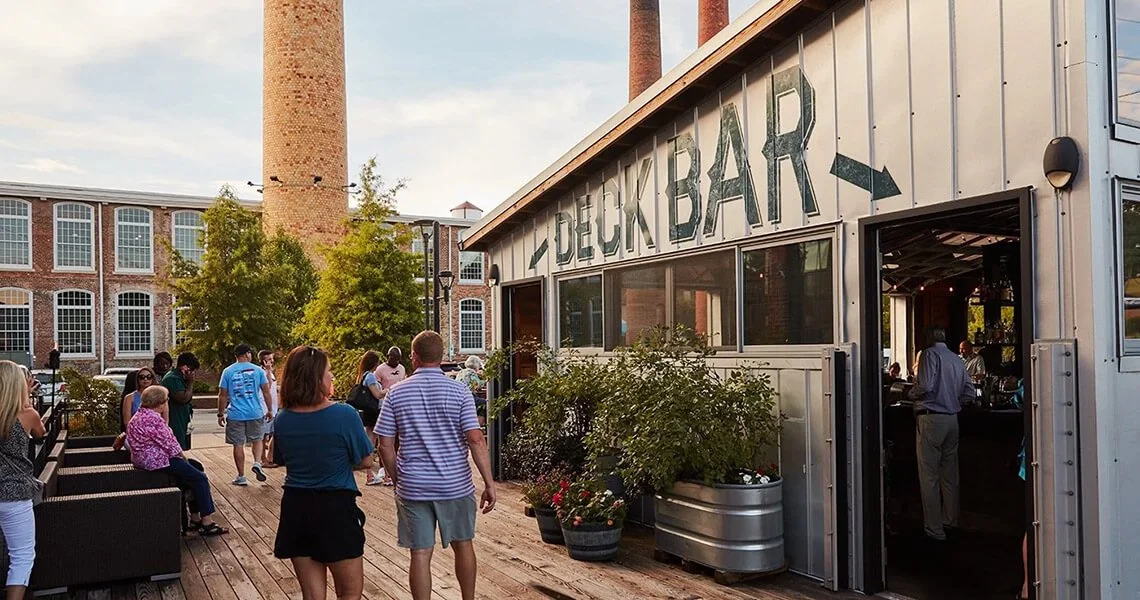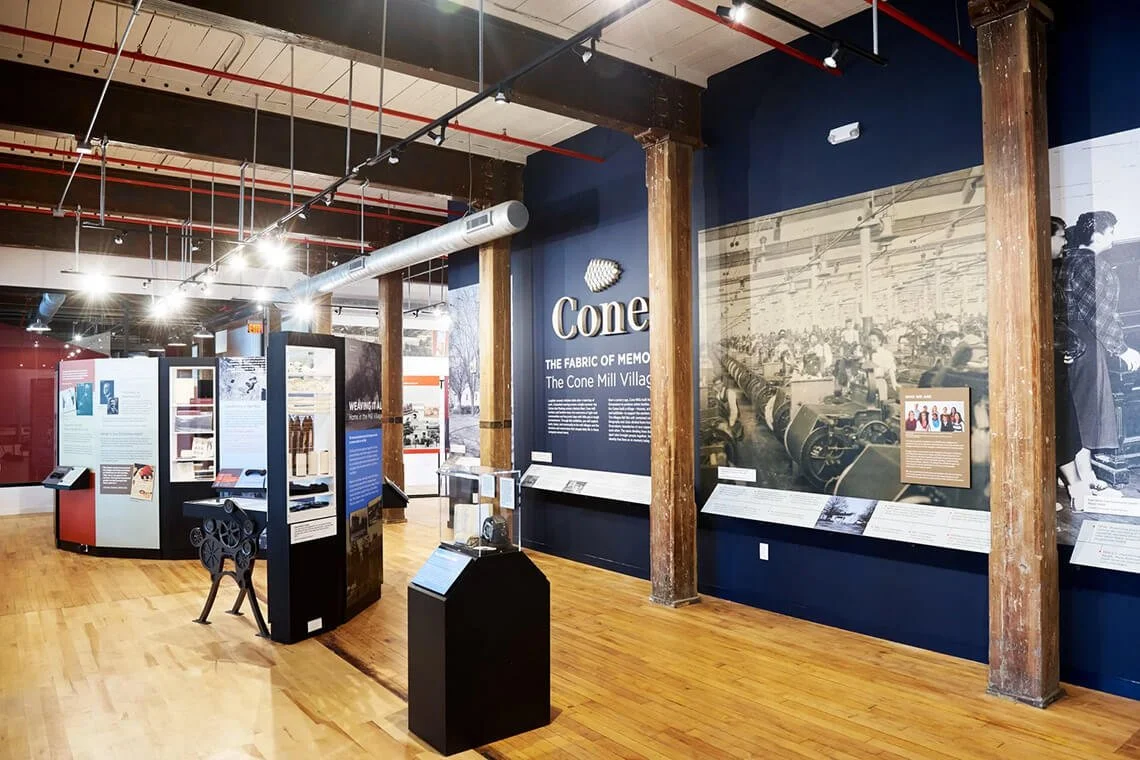Architects and developers are transforming these staples of the South—located throughout a 120-mile region from Winston-Salem to Fayetteville—into infrastructure fit for today.
When architect Louis Cherry first walked into the Adams-Millis Hosiery Mill, a 1920s factory in High Point, North Carolina, his jaw dropped. “It was majestic, almost like a Greek stoa,” he says of the cast-in-place concrete structure and the two-foot-wide columns with flare mushroom cap tops and square drop caps. Designed to facilitate intricate work, the mill had narrow floor plates and could allow for “all kinds of natural light” despite windows that had been boarded up over the years. “I saw the potential for this to be a gorgeous space.”
The Adams-Millis Hosiery Mill is just one of a constellation of old mills and factories dotting the North Carolina landscape. Known for its history of tobacco, furniture, and textile manufacturing, the region has come a long way since the industry’s decline in the early 20th century, with the ghostly industrial shells being transformed into hardy buildings. Over the past few decades, a fervent army of developers, architects, and community leaders from Durham to Winston-Salem have joined hands to repurpose these staples of the South into infrastructure fit for today.
Congdon Yards, High Point
This spring, High Point’s Adams-Millis Hosiery became Congdon Yards. Twice a year, the city hosts High Point Market, ushering in 75,000 people and 2,000 exhibitors from around the globe. Building on the city’s status as the “furniture capital of the world,” the old mill has been converted into a 225,000-square-foot design hub for furniture designers and entrepreneurs.
Congdon Yards consists of three buildings wrapped around a parking lot-turned-courtyard: Plant 7, an L-shaped assemblage of two buildings, and The Factory, a brick structure with oak floors and timber columns. Repurposing the 100-year-old factory didn’t come easy. For example, the L-shaped building at Plant 7 spanned five floors on one side and four on the other, so most floors didn’t align. “My idea was to cut a big hole in the middle where they come together and create a very dramatic cascading atrium,” says Cherry, who designed a steel stair that now snakes around the elevator core, connecting every level.
Today, Plant 7 houses workspaces, a large community space on the ground floor, and a 6,070-square-foot workshop with commercial-grade woodworking equipment that is open to the public and available to designers and artisans. The Factory includes four event spaces and a restaurant on the ground floor. In a bid to avoid seasonal activities that leave the area desolate when businesses are closed, showrooms are excluded by zoning. “The idea has been to create a new downtown that is a 365 days-a-year downtown,” says Cherry.
Bailey South, Winston-Salem
This shift to a new center of gravity in town is not an isolated example. In Winston-Salem, Innovation Quarter is a 1.2 million-square-foot research center housed in a series of repurposed R.J. Reynolds Tobacco Co. factories that hug Bailey Park–an old parking lot that’s been transformed into a 1.6-acre urban green space.
Once a tobacco and textiles manufacturing powerhouse, Winston-Salem, and particularly Innovation Quarter, now attracts students, artists, entrepreneurs, and executives looking for a vibrant community and creative collaborations. The coal-fired power plant which had stood dormant for over 20 years, has been transformed into Bailey South, a mixed-use retail and office space. “Historically all of the factories were built with excess capacity in mind, but that’s allowed for these buildings to be repurposed,” says Ben Schwab, a partner at local architecture firm STITCH Design Shop, which designed Bailey South, as well as the amphitheater in Bailey Park.
At Bailey South, STITCH Design Shop reused 97 percent of the existing power plant building. They then built a two-story addition to the south, and a six-story addition to the north, creating what Schwab calls a “common language” between them. Like at Congdon Yards, where the architects left a fair share of warts and dings, many of the building’s original quirks, like the 2 to 6-feet wide holes that had been cut for pipes, were kept and celebrated. Stitch also preserved the historic elevated railroad trestle that once brought coal to the power plant: it now provides access to the building’s second-floor office and retail entrance.
Revolution Mill, Greensboro
What to keep and what to shed is the challenge of every adaptive reuse project. In Greensboro, a former Cone Mills flannel factory has been transformed into a mixed-use complex abuzz with shops, offices, restaurants, and apartments. Designed by Eddie Belk of Belk Architecture, the complex consists of two long rows of connected buildings set around a courtyard that, over the years, had been filled with storage warehouses. “In order to bring back a warm, energizing space, we took those cores out and reopened all those windows so both rows of buildings had good views,” says Belk.
The mill closed in 1982, and much of the complex sat empty for decades. In 2012, Self Help Ventures Fund bought the mill and leveraged historic tax credits to bring it back to life. The main campus was complete in 2019 and Belk is now working on converting an old distribution warehouse into a new complex with two restaurants, additional coworking space, and 33 more apartments, making the number of living units a total of 183, including a portion dedicated to affordable housing. “There’s no greener building than the one that’s already built,” says Belk.
With over 84 adaptive reuse projects across North Carolina and Virginia, Belk has made a career of reinventing the past. He was the master planner for the American Tobacco Campus in Durham, completed in 2005, as well as the architect of Brightleaf Square nearby—a mixed-use campus in a set of converted tobacco warehouses. Both projects are now widely accepted as a catalyst for modern-day Durham, and for adaptive reuse projects in the area.
In the last ten years, Belk has designed half a dozen charter schools in old factory buildings. And in Rocky Mount, he transformed the second oldest cotton mill in North Carolina into an 82-acre modern-day campus. “There’s a reason I’ve been addicted to this for 40 years,” he says. “When I [renovate] the cotton mills, I feel like I’m walking in my grandfather’s footsteps, and I hope by adaptively reinventing these buildings, that we allow our grandchildren to walk in our footsteps.”































